 Technology peripherals
Technology peripherals
 AI
AI
 The Stable Diffusion 3 paper is finally released, and the architectural details are revealed. Will it help to reproduce Sora?
The Stable Diffusion 3 paper is finally released, and the architectural details are revealed. Will it help to reproduce Sora?
The Stable Diffusion 3 paper is finally released, and the architectural details are revealed. Will it help to reproduce Sora?
The paper for Stable Diffusion 3 is finally here!
This model was released two weeks ago and uses the same DiT (Diffusion Transformer) architecture as Sora. It caused quite a stir upon release.
Compared with the previous version, the quality of images generated by Stable Diffusion 3 has been significantly improved. It now supports multi-theme prompts, and the text writing effect has also been improved, and garbled characters no longer appear. Condition.
Stability AI pointed out that Stable Diffusion 3 is a series of models with parameter sizes ranging from 800M to 8B. This parameter range means that the model can be run directly on many portable devices, significantly lowering the threshold for using large AI models.
In a newly released paper, Stability AI said that in human preference-based evaluations, Stable Diffusion 3 outperformed current state-of-the-art text-to-image generation systems such as DALL・E 3. Midjourney v6 and Ideogram v1. Soon, they will make the experimental data, code, and model weights of the study publicly available.
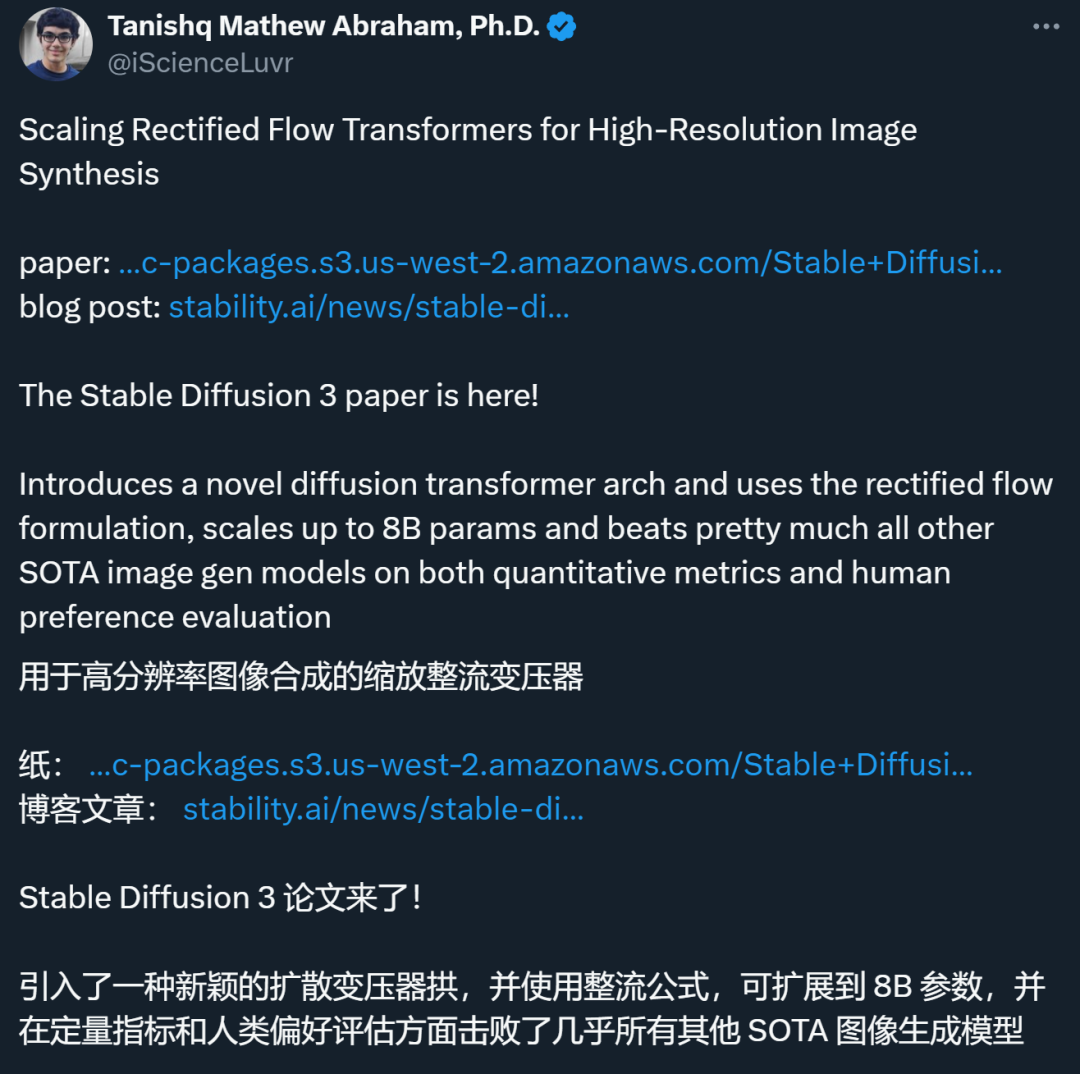
In the paper, Stability AI revealed more details about Stable Diffusion 3.

- ##Paper title: Scaling Rectified Flow Transformers for High-Resolution Image Synthesis
- Paper link: https://stabilityai-public-packages.s3.us-west-2.amazonaws.com/Stable Diffusion 3 Paper.pdf
Architectural details
For text-to-image generation, the Stable Diffusion 3 model must consider both text and image modes. Therefore, the authors of the paper call this new architecture MMDiT, referring to its ability to handle multiple modalities. As with previous versions of Stable Diffusion, the authors use pre-trained models to derive suitable text and image representations. Specifically, they used three different text embedding models—two CLIP models and T5—to encode text representations, and an improved autoencoding model to encode image tokens.

Stable Diffusion 3 model architecture.
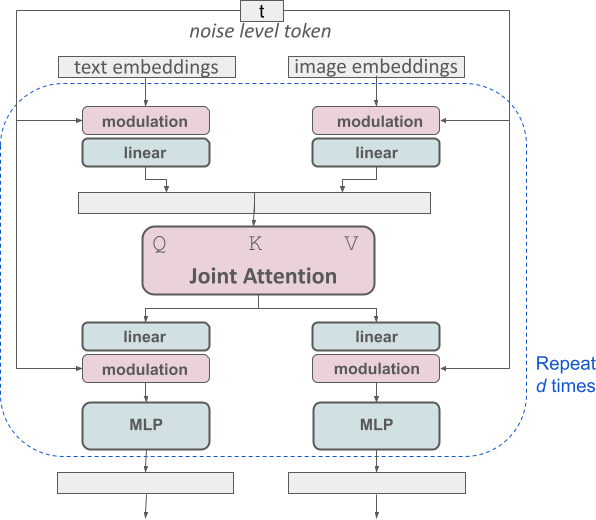
Improved multimodal diffusion transformer: MMDiT block.
The SD3 architecture is based on DiT proposed by Sora core R&D member William Peebles and Xie Saining, assistant professor of computer science at New York University. Since text embedding and image embedding are conceptually very different, the authors of SD3 use two different sets of weights for the two modalities. As shown in the figure above, this is equivalent to setting up two independent transformers for each modality, but combining the sequences of the two modalities for attention operations, so that both representations can work in their own space, Another representation is also taken into account.
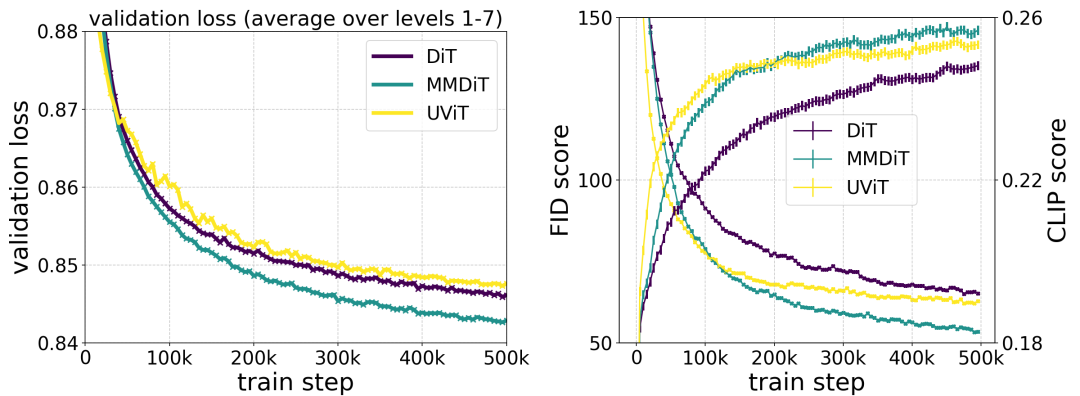
The author's proposed MMDiT architecture outperforms mature textual frameworks such as UViT and DiT when measuring visual fidelity and text alignment during training. to the image backbone.
In this way, information can flow between image and text tokens, thereby improving the overall understanding of the model and improving the typography of the generated output. As discussed in the paper, this architecture is also easily extensible to multiple modalities such as video.

Thanks to Stable Diffusion 3’s improved prompt following capabilities, the new model has the ability to produce images that focus on a variety of different themes and qualities, At the same time, it can also handle the style of the image itself with a high degree of flexibility.
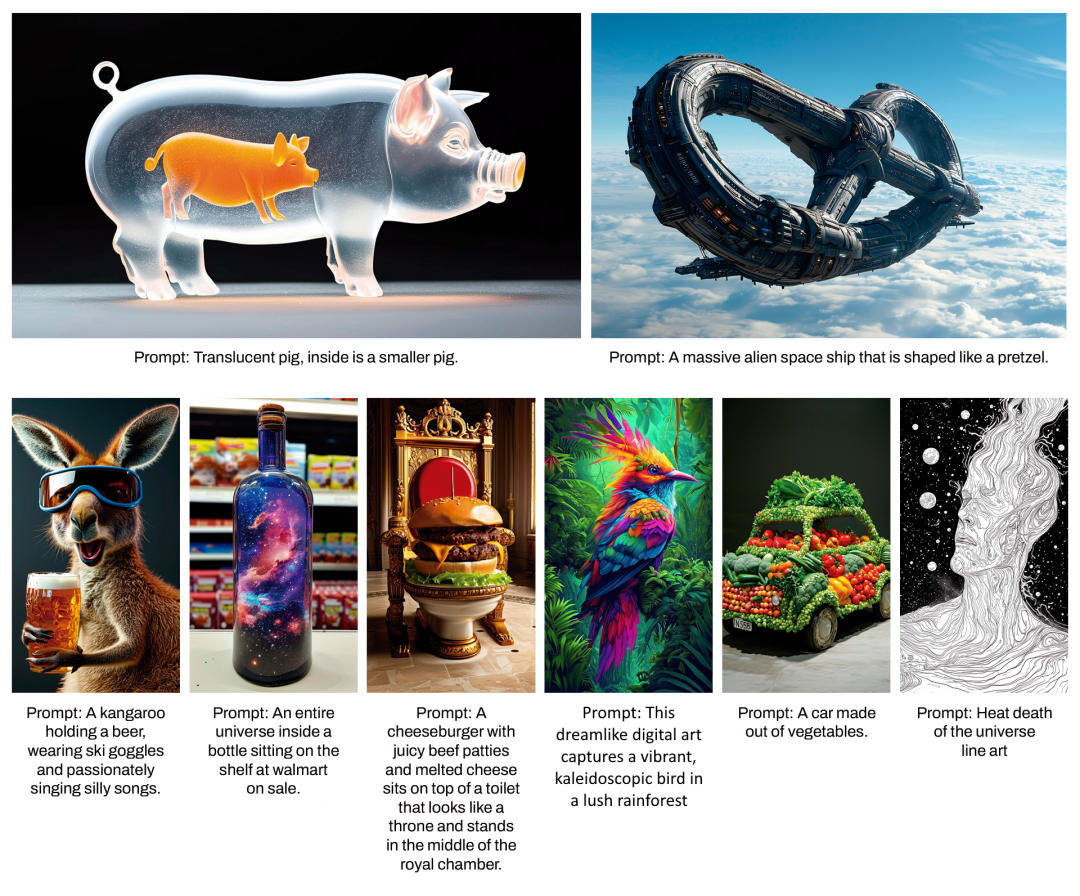
Improve Rectified Flow through re-weighting
Stable Diffusion 3 uses the Rectified Flow (RF) formula. During the training process, Data and noise are connected in a linear trajectory. This makes the inference path straighter, thus reducing sampling steps. In addition, the authors also introduce a new trajectory sampling scheme during the training process. They hypothesized that the middle part of the trajectory would pose a more challenging prediction task, so the scheme gave more weight to the middle part of the trajectory. They compared using multiple datasets, metrics and sampler settings and tested their proposed method against 60 other diffusion trajectories such as LDM, EDM and ADM. The results show that while the performance of previous RF formulations improves with few sampling steps, their relative performance decreases as the number of steps increases. In contrast, the reweighted RF variant proposed by the authors consistently improves performance.
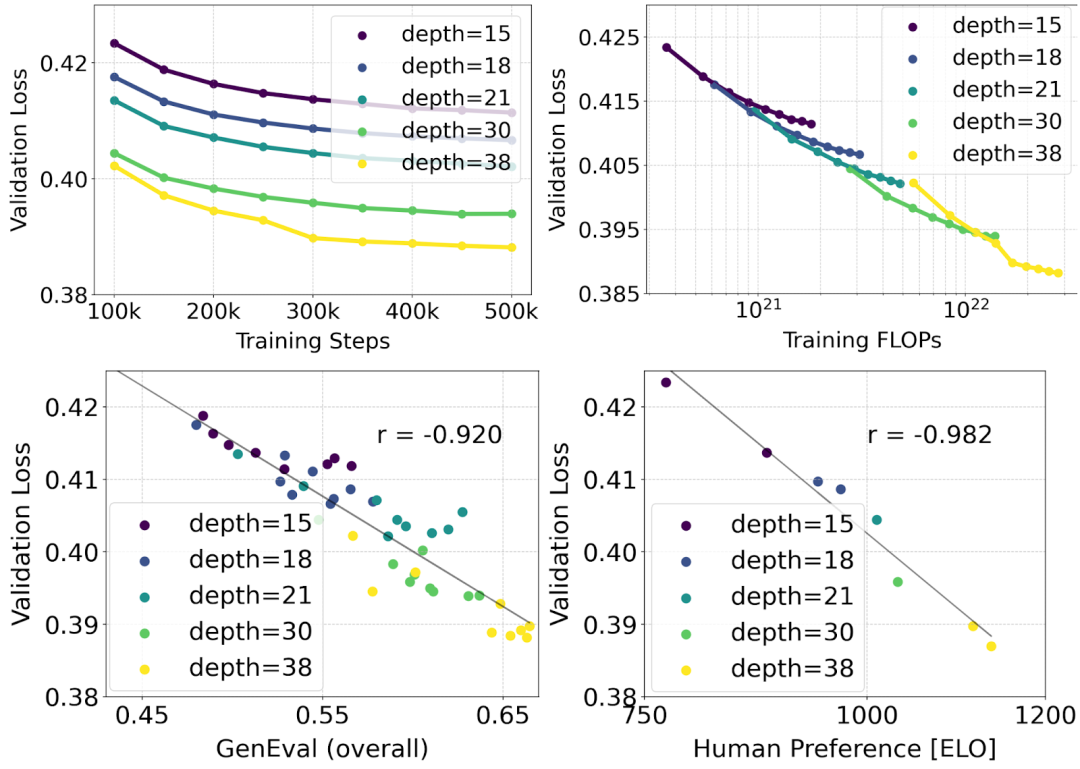
Extended Rectified Flow Transformer model
The author uses the reweighted Rectified Flow formula and MMDiT backbone pair Text-to-image synthesis is studied in scaling. They trained models ranging from 15 blocks with 450M parameters to 38 blocks with 8B parameters and observed that the validation loss decreased smoothly with increasing model size and training steps (first part of the figure above OK). To examine whether this translated into meaningful improvements in model output, the authors also evaluated the automatic image alignment metric (GenEval) and the human preference score (ELO) (second row above). The results show a strong correlation between these metrics and validation loss, suggesting that the latter is a good predictor of the overall performance of the model. Furthermore, the scaling trend shows no signs of saturation, making the authors optimistic about continuing to improve model performance in the future.
Flexible text encoder
By removing memory intensive 4.7B parameter T5 text encoder for inference, SD3 memory Demand can be significantly reduced with minimal performance loss. As shown, removing this text encoder has no impact on visual aesthetics (50% win rate without T5) and only slightly reduces text consistency (46% win rate). However, the authors recommend adding T5 when generating written text to fully utilize the performance of SD3, because they observed that without adding T5, the performance of generating typesetting dropped even more (win rate 38%), as shown in the following figure:
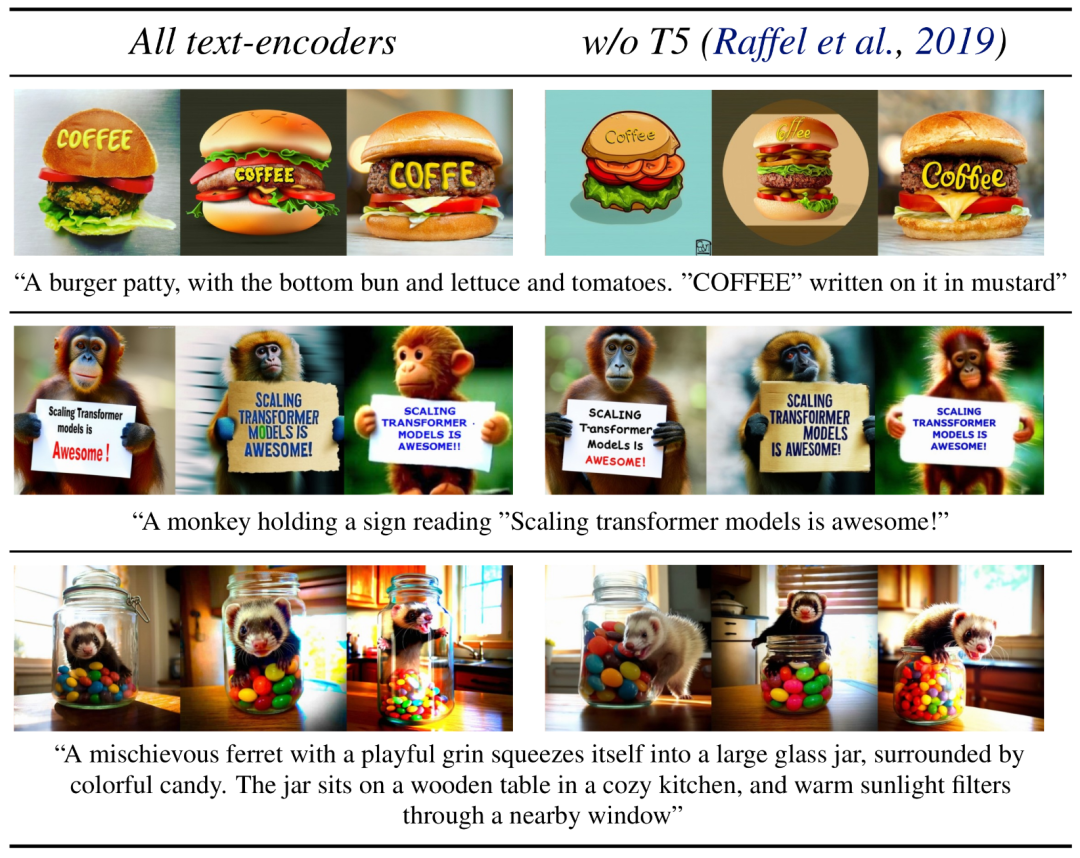
#Removing T5 for inference will only result in a significant decrease in performance when presenting very complex prompts involving many details or large amounts of written text. The image above shows three random samples of each example.
Model performance
The author compared the output image of Stable Diffusion 3 with various other open source models (including SDXL, SDXL Turbo, Stable Cascade, Playground v2.5 and Pixart-α) as well as closed-source models such as DALL-E 3, Midjourney v6 and Ideogram v1 were compared to evaluate performance based on human feedback. In these tests, human evaluators are given examples of output from each model and judged on how well the model output follows the context of the prompt given (prompt following), how well the text is rendered according to the prompt (typography), and which image Images with higher visual aesthetics are selected for the best results.
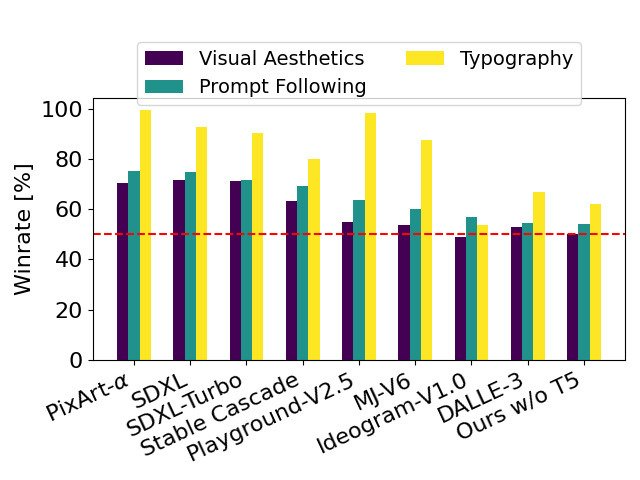
#Using SD3 as the benchmark, this chart outlines its win rate based on human evaluation of visual aesthetics, prompt following, and text layout.
From the test results, the author found that Stable Diffusion 3 is equivalent to or even better than the current state-of-the-art text-to-image generation systems in all the above aspects.
In early unoptimized inference testing on consumer hardware, the largest 8B parameter SD3 model fit the RTX 4090's 24GB VRAM, using 50 sampling steps to generate a resolution of 1024x1024 Image takes 34 seconds.
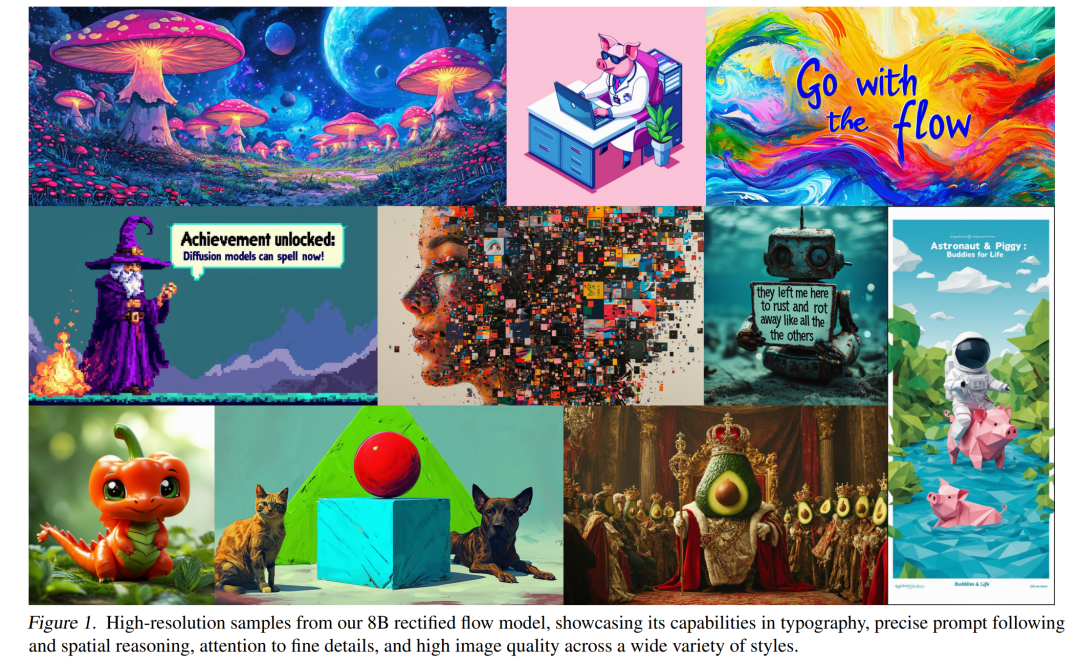
Additionally, at initial release, Stable Diffusion 3 will be available in multiple variants, ranging from 800m to 8B parametric models to further eliminate hardware barriers.
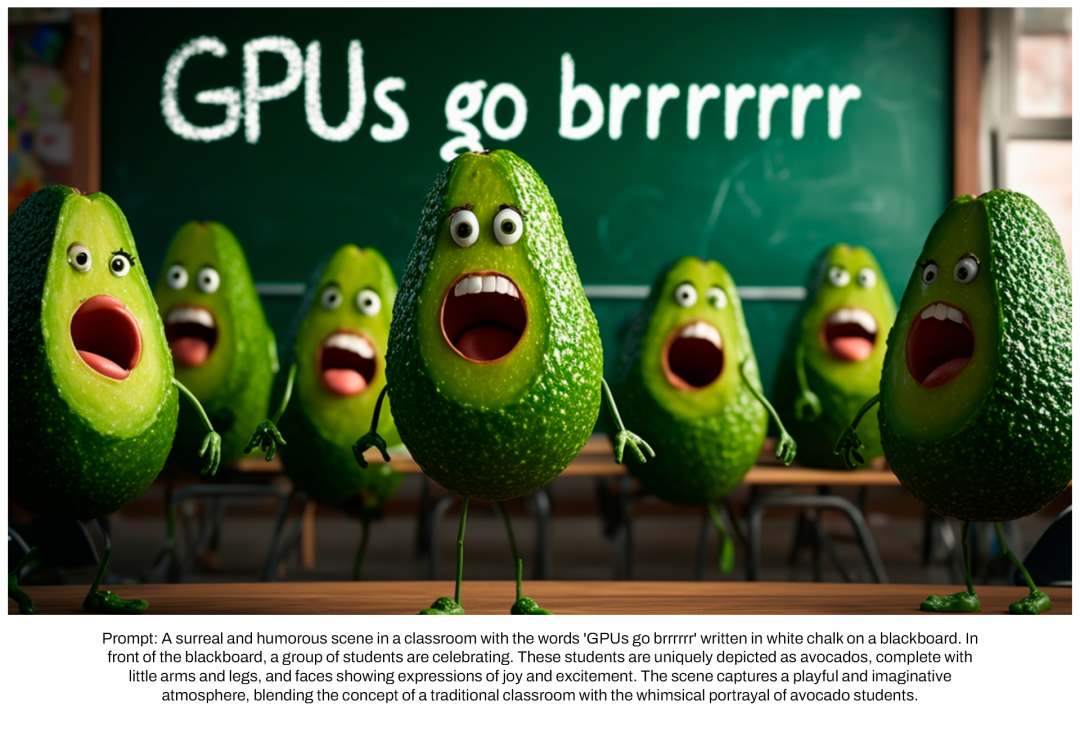

Please refer to the original paper for more details.
Reference link: https://stability.ai/news/stable-diffusion-3-research-paper
The above is the detailed content of The Stable Diffusion 3 paper is finally released, and the architectural details are revealed. Will it help to reproduce Sora?. For more information, please follow other related articles on the PHP Chinese website!

Hot AI Tools

Undresser.AI Undress
AI-powered app for creating realistic nude photos

AI Clothes Remover
Online AI tool for removing clothes from photos.

Undress AI Tool
Undress images for free

Clothoff.io
AI clothes remover

AI Hentai Generator
Generate AI Hentai for free.

Hot Article

Hot Tools

Notepad++7.3.1
Easy-to-use and free code editor

SublimeText3 Chinese version
Chinese version, very easy to use

Zend Studio 13.0.1
Powerful PHP integrated development environment

Dreamweaver CS6
Visual web development tools

SublimeText3 Mac version
God-level code editing software (SublimeText3)

Hot Topics
 1378
1378
 52
52
 How to set the Debian Apache log level
Apr 13, 2025 am 08:33 AM
How to set the Debian Apache log level
Apr 13, 2025 am 08:33 AM
This article describes how to adjust the logging level of the ApacheWeb server in the Debian system. By modifying the configuration file, you can control the verbose level of log information recorded by Apache. Method 1: Modify the main configuration file to locate the configuration file: The configuration file of Apache2.x is usually located in the /etc/apache2/ directory. The file name may be apache2.conf or httpd.conf, depending on your installation method. Edit configuration file: Open configuration file with root permissions using a text editor (such as nano): sudonano/etc/apache2/apache2.conf
 How to optimize the performance of debian readdir
Apr 13, 2025 am 08:48 AM
How to optimize the performance of debian readdir
Apr 13, 2025 am 08:48 AM
In Debian systems, readdir system calls are used to read directory contents. If its performance is not good, try the following optimization strategy: Simplify the number of directory files: Split large directories into multiple small directories as much as possible, reducing the number of items processed per readdir call. Enable directory content caching: build a cache mechanism, update the cache regularly or when directory content changes, and reduce frequent calls to readdir. Memory caches (such as Memcached or Redis) or local caches (such as files or databases) can be considered. Adopt efficient data structure: If you implement directory traversal by yourself, select more efficient data structures (such as hash tables instead of linear search) to store and access directory information
 How to implement file sorting by debian readdir
Apr 13, 2025 am 09:06 AM
How to implement file sorting by debian readdir
Apr 13, 2025 am 09:06 AM
In Debian systems, the readdir function is used to read directory contents, but the order in which it returns is not predefined. To sort files in a directory, you need to read all files first, and then sort them using the qsort function. The following code demonstrates how to sort directory files using readdir and qsort in Debian system: #include#include#include#include#include//Custom comparison function, used for qsortintcompare(constvoid*a,constvoid*b){returnstrcmp(*(
 Debian mail server firewall configuration tips
Apr 13, 2025 am 11:42 AM
Debian mail server firewall configuration tips
Apr 13, 2025 am 11:42 AM
Configuring a Debian mail server's firewall is an important step in ensuring server security. The following are several commonly used firewall configuration methods, including the use of iptables and firewalld. Use iptables to configure firewall to install iptables (if not already installed): sudoapt-getupdatesudoapt-getinstalliptablesView current iptables rules: sudoiptables-L configuration
 Debian mail server SSL certificate installation method
Apr 13, 2025 am 11:39 AM
Debian mail server SSL certificate installation method
Apr 13, 2025 am 11:39 AM
The steps to install an SSL certificate on the Debian mail server are as follows: 1. Install the OpenSSL toolkit First, make sure that the OpenSSL toolkit is already installed on your system. If not installed, you can use the following command to install: sudoapt-getupdatesudoapt-getinstallopenssl2. Generate private key and certificate request Next, use OpenSSL to generate a 2048-bit RSA private key and a certificate request (CSR): openss
 How debian readdir integrates with other tools
Apr 13, 2025 am 09:42 AM
How debian readdir integrates with other tools
Apr 13, 2025 am 09:42 AM
The readdir function in the Debian system is a system call used to read directory contents and is often used in C programming. This article will explain how to integrate readdir with other tools to enhance its functionality. Method 1: Combining C language program and pipeline First, write a C program to call the readdir function and output the result: #include#include#include#includeintmain(intargc,char*argv[]){DIR*dir;structdirent*entry;if(argc!=2){
 How Debian OpenSSL prevents man-in-the-middle attacks
Apr 13, 2025 am 10:30 AM
How Debian OpenSSL prevents man-in-the-middle attacks
Apr 13, 2025 am 10:30 AM
In Debian systems, OpenSSL is an important library for encryption, decryption and certificate management. To prevent a man-in-the-middle attack (MITM), the following measures can be taken: Use HTTPS: Ensure that all network requests use the HTTPS protocol instead of HTTP. HTTPS uses TLS (Transport Layer Security Protocol) to encrypt communication data to ensure that the data is not stolen or tampered during transmission. Verify server certificate: Manually verify the server certificate on the client to ensure it is trustworthy. The server can be manually verified through the delegate method of URLSession
 How to do Debian Hadoop log management
Apr 13, 2025 am 10:45 AM
How to do Debian Hadoop log management
Apr 13, 2025 am 10:45 AM
Managing Hadoop logs on Debian, you can follow the following steps and best practices: Log Aggregation Enable log aggregation: Set yarn.log-aggregation-enable to true in the yarn-site.xml file to enable log aggregation. Configure log retention policy: Set yarn.log-aggregation.retain-seconds to define the retention time of the log, such as 172800 seconds (2 days). Specify log storage path: via yarn.n




